Preliminary Android 3.0 SDK reveals new delights
Jan 26, 2011 — by Eric Brown — from the LinuxDevices Archive — 1 viewsThe Google-sponsored Android project has released a preview software developers kit (SDK) for the tablet-oriented Android 3.0 (“Honeycomb”). In the process, it has revealed many more details about Android 3.0, including a revamped “holographic” UI, redesigned keyboard, a new animation framework and graphics engines, and enhanced Bluetooth support — among many other changes.
The preview version of the Android 3.0 SDK features "non-final APIs and system image," and apps developed with it cannot be published to Android Market, writes Xavier Ducrohet, Android SDK Tech Lead in a Jan. 26 blog announcement. Still, the SDK should allow developers to start testing their existing applications on the tablet form factor, he adds. A final SDK is promised to be released "in the weeks ahead."
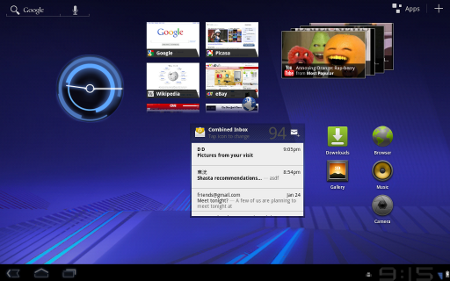
Android 3.0 main screen
(Click to enlarge)
As indicated in the feature highlights later in this story, Android 3.0 also adds a new top-line, app-driven Action Bar and an omnipresent, bottom-line System Bar. Among other UI enhancements, the soft keyboard has been redesigned, cut and paste has been streamlined, and thumbnails are provided for recent open apps in order to ease multitasking (see image below).
There have been major upgrades to the browser, camera app, contact, and email apps, Google adds.
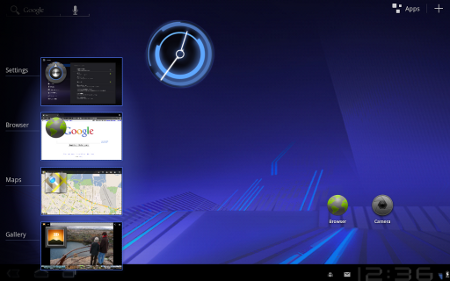
Task thumbnails for recent apps
(Click to enlarge)
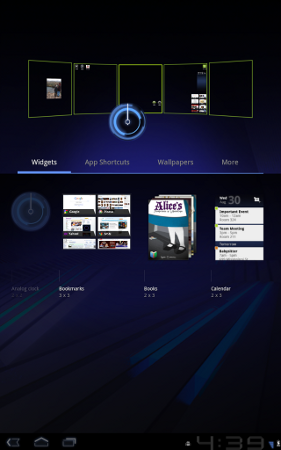
New visual layout mode for home-screen customization
(Click to enlarge)
Finally, the new release offers a variety of new connectivity APIs, most of which seem to focus on more advanced Bluetooth support, an area where Android has always lagged.
Google stresses that Honeycomb is backward-compatible to existing Android apps. The SDK offers developers the "flexibility to adapt existing apps to the new UI while maintaining compatibility with earlier platform versions and other form-factors," writes Ducrohet.
Existing apps can be integrated into the holographic UI theme "without code changes, by adding a single attribute in their manifest files," says Google. For example, the Android 3.0 SDK emulates the existing Menu key, which is replaced by a new "overflow menu" in the Action Bar. Developers can also "create dedicated layouts and assets for larger screens and add them to their existing applications," says Google.
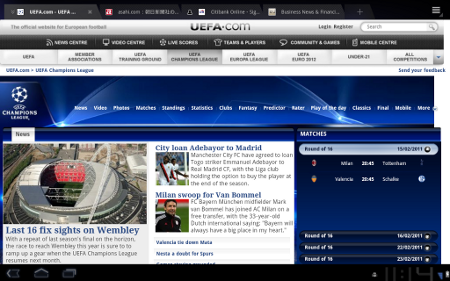
Honeycomb's revamped browser
(Click to enlarge)
Android 3.0 obviously offers support for screens of at least 10.1 inches and 1280 x 800 pixels — specs that have been announced for Honeycomb-ready tablets like the Motorola Xoom and Toshiba Tablet among others. Meanwhile, we also know that at least one 7.1-inch tablet will run Android 3.0, with the announcement of the Asus Eee Pad MeMo.
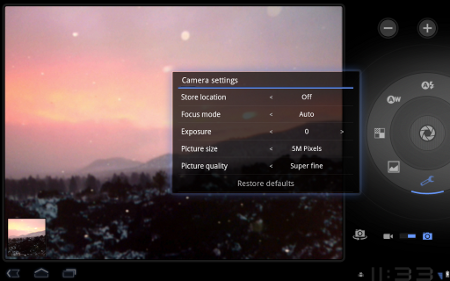
Camera app, redesigned for the big screen
(Click to enlarge)
- UI framework optimized for larger screen devices — New UI components and themes are available, as well as richer widgets and notifications, and drag and drop target larger screen devices, says Google. UI enhancements include:
- System bar — New universal, bottom-line system bar, offering quick access to notifications, system status, and soft navigation buttons, is always on, but can be dimmed for videos, etc.
- Action bar — The top-line action bar is also omnipresent, but is managed by individual apps, offering contextual options, navigation, widgets, or other content.
- Customizable home screens — Five customizable home screens offer different contextual views, and feature large grids that maintain spatial arrangement in all orientations. Other features include a dedicated visual layout mode (pictured farther above), visual cues and drop shadows, an app launcher, and a universal search function.
- Recent apps view — The system launcher offers thumbnails of the most recent state of current tasks (apps), for easier multitasking.
- Redesigned keyboard — The virtual "soft" keyboard has been reshaped and repositioned for improved targeting on larger screens. It includes a new Tab key, special character menus, and voice/text switch key.
- Cut and paste enhancements — Users can now quickly select a word by press-hold, and then adjust the selection area by dragging bounding arrows. They can then select actions from the Action Bar, such as copy, share, paste, web search, or find.
- Activity fragments — An app's "activities" can now be divided into subcomponents called "fragments," and then recombined. For example, a set of fragments can be used to create a true multipane UI, with the user being able to interact with each pane independently. Fragments can be added, removed, replaced, and animated inside an activity dynamically, and they are modular and reusable across multiple activities. Due to this modularity, apps developers can more easily recast apps for larger or smaller screens, says Google
- Redesigned UI widgets and home-screen widgets — UI widgets have been redesigned for use on larger screens with the holographic UI theme. New widget types include a 3D stack, search box, date/time picker, number picker, calendar, and popup menu. Home screen widgets have also been enhanced with new modes of interaction, including gesture support.
- Graphics and animation improvements — A new property-based animation framework supports the development of more advanced visual effects, and an integrated GL renderer lets developers request hardware acceleration of common 2D rendering operations, either across the entire app or only in specific activities or views. There's also a new 3D graphics engine called Renderscript.
- Multicore support — Android 3.0 is now optimized to run on dual-core processors, as well as single-core chips.
- Multimedia improvements — Honeycomb features HTTP Live streaming support, a pluggable DRM framework, and "easy media file transfer" using MTP/PTP to enable richer multimedia content, says Google.
- New connectivity APIs are available, including:
- Bluetooth A2DP and HSP APIs, supporting audio streaming and headset control
- support for Bluetooth's insecure socket connection for connecting to simple devices with primitive or nonexistent UIs
- ability to connect full keyboards over either USB or Bluetooth
- support for Bluetooth tethering
- Wi-Fi combo scan for reducing scan times across bands and filters
- Media/Photo Transfer Protocol for instantly syncing media files with a USB-connected camera or PC
- Enterprise enhancements — Android 3.0 is said to support new administrative policies, such as enterprise-focused policies for encrypted storage and password expiration.
- Browser — The browser now offers multiple tabs in place of windows, plus an "incognito" mode for anonymous browsing, and a unified view for bookmarks and history. Also new are an automatic sign-on to Google sites, bookmark sync with Chrome, and new multitouch support in JavaScript and plugins. Additional novelties include an improved zoom and viewport model, overflow scrolling, and support for fixed positioning.
- Camera — Redesigned for larger screens, the camera app now offers more streamlined access to exposure, focus, flash, zoom, and the front-facing camera. The Gallery app lets users view albums in full-screen mode, with easy access to album-external thumbnails.
- Contact and email — There's a new a card-like UI for contacts, and a new two-pane UI and Fast Scroll for streamlined organization. There's also improved international phone number formatting and parsing. The Email app also uses a new two-pane UI, and enables selection of one or more messages for grouped actions, and users can sync attachments for later viewing.
In conjunction with the Android 3.0 preliminary SDK release, Google's Android Developers project is releasing updates to its SDK Tools (r9), NDK (Native code Development Kit), version r5b, and ADT Plugin for Eclipse 9.0.0.
The key features in these releases are said to be linked to UI Builder improvements to the ADT Plugin. These are said to include improved drag-and-drop in the editor, with better support for included layouts, as well as an in-editor preview of animated objects. In addition, the ADT Plugin now offers visualization of UIs based on any version of the platform, independent of project target, as well as improved rendering, with better support for custom views.
Availability
The blog announcement for the preliminary Android 3.0 SDK, with links to downloads, may be found here, and more information may be found in this Android 3.0 Platform Highlights page.
This article was originally published on LinuxDevices.com and has been donated to the open source community by QuinStreet Inc. Please visit LinuxToday.com for up-to-date news and articles about Linux and open source.